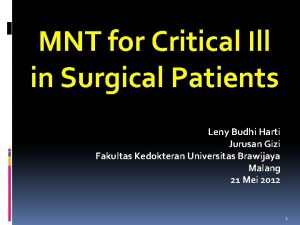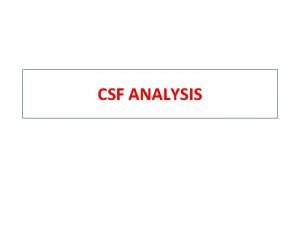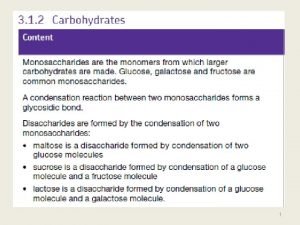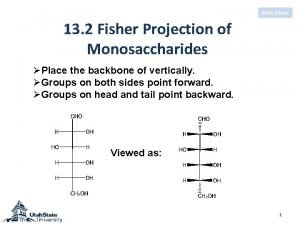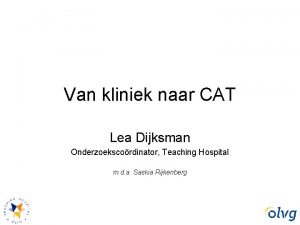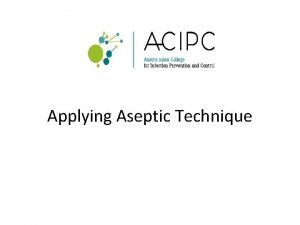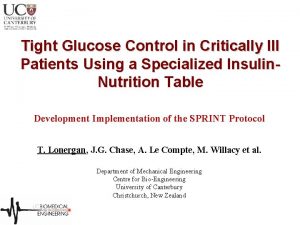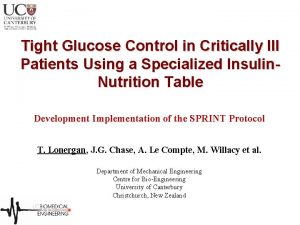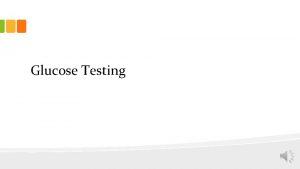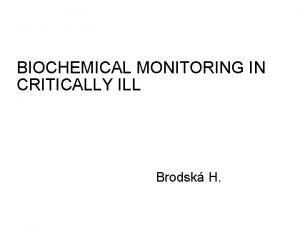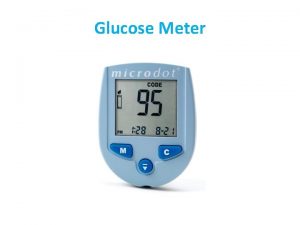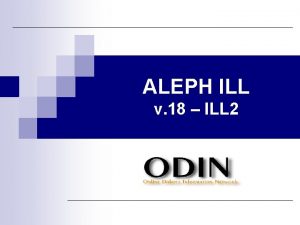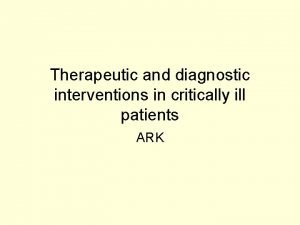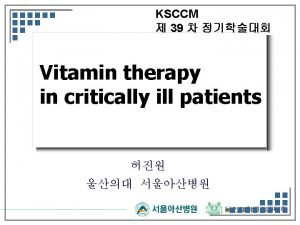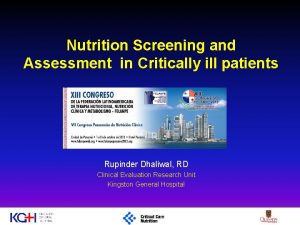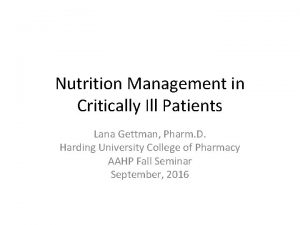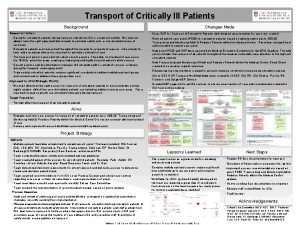Tight Glucose Control in Critically Ill Patients Using













- Slides: 13

Tight Glucose Control in Critically Ill Patients Using a Specialized Insulin. Nutrition Table Development Implementation of the SPRINT Protocol T. Lonergan, J. G. Chase, A. Le Compte, M. Willacy et al. Department of Mechanical Engineering Centre for Bio-Engineering University of Canterbury Christchurch, New Zealand

Overview • Background – Stress-induced hyperglycaemia – Active Insulin Control (AIC) • SPRINT – Introduction – Development • Clinical Testing and Results

Background § Stress-Induced hyperglycaemia prevalent in critical care § Impaired endogenous insulin production § Increased effective insulin resistance § Average blood glucose values > 10 mmol/L not uncommon in some critical care units (over length of stay) § Tight control better outcomes: § Reduced mortality 27 -43% (4. 0 -7. 75 mmol/L) [van den Berghe et al, 2001; Krinsley, 2004; …] § Reduced length of stay and length of mechanical ventilation Goal: Keep Blood Glucose ~Normal (4. 0 – 6. 0 mmol/L, 75 – 110 dg/m. L)

Active Insulin Control Evolution AIC 1 – 3 Development of Mathematical Model + 1 st Trials Insulin-only AIC 4 Computerised Control Protocol Insulin + Nutrition AIC 5 • Develop new protocol with same (or better) control • Easy to implement in clinical environment • Compare to international protocols

SPRINT Step 1 = Feed Rate Table Requires current glucose measurement and last hour change in glucose

SPRINT Step 2 = Insulin Table If feed rate = 0 use only insulin wheel Requires current glucose measurement, last hour change and last hours insulin bolus

Clinical Testing • Virtual trials using fitted long term patient data to create virtual patient responses – Tests algorithms and methods safely – Provides insight into potential long term usage • 33+ Clinical trials in Christchurch ICU – Clinical proof of concept – Ethical consent granted by Canterbury Ethics Committee – Process Improvement Change

Development & Protocol Comparison SPRINT Protocol AIC 4 Protocol Mayo Clinic Protocol (Krinsley) • Goal #1 = SPRINT ≥ Best Clinical Practice • Goal #2 = Effectiveness of AIC 4 with ease of Leuven Protocol (van den Berghe et al) Bath University Protocol Yale University Protocol CDHB Insulin Sliding Scale Protocol Aggressive Insulin Sliding Scale Protocol • Use same virtual trial cohort as previously to test all protocols Insulin rate BG level Standard Aggressive < 4 mmol/L 0 U/hr 4 – 5. 9 mmol/L 1 U/hr 6 – 7. 9 mmol/L 2 U/hr 8 – 9. 9 mmol/L 3 U/hr 4 U/hr 10 – 11. 9 mmol/L 4 U/hr 6 U/hr 12 – 13. 9 mmol/L 5 U/hr 6 U/hr >= 14 mmol/L 6 U/hr

Protocol Comparison Results 45% 25% Bad! Very Bad! Also Bad! Not Trying?

Clinical Results • 4688 total hours of control • 3578 measurements (47. 4% two-hourly) • • Overall Average BG = 5. 9 +/- 0. 9 mmol/L Time in 4 -6. 1 mmol/L = 59. 363% Time in 4 -7. 0 mmol/L = 86% Time in 4 -7. 75 mmol/L = 94% Extremely tight control ! • Percentage of measurements < 4 mmol/L = 1. 8% • Percentage of measurements < 3 mmol/L = 0. 0% • Minimum 3. 1 mmol/L

Clinical Results • Average Insulin = 2. 6 U/hr • Average Feed = 62% = 1150 kcal/day!!!! – versus prior hospital rate of 58%! • Age: Mean = 55, Range = 27 -84 • • APACHE II (Risk of Death) = 20 (36. 7%) APACHE III = 58 SAPS II (Risk of Death) = 43 (33. 3%) Mortality (at ICU discharge) = 24. 2%

Conclusions • Implemented tight glycaemic control into the ICU – – Developed a simple, easy-to-use system: SPRINT High compliance by clinical staff due to ease of use Performance amongst the best in the world 33+ patients and growing • Clinical results match desired outcomes – Exceed published protocols by 3 -5 x on variation – Better average glucose for same or less insulin – Much more critically ill cohort

Acknowledgements Jessica Lin & AIC 3 Thomas Lotz Assoc. Prof. Geoff Chase Jason Wong & AIC 4 Dunedin Dr Kirsten Mc. Auley AIC 2 & Dr. G. Shaw Mike Willacy Aaron Le Compte The Danes Prof Steen Andreassen Prof Jim Mann Maths and Stats Gurus Dr Dom Lee Dr Bob Broughton. Prof Graeme Wake Dr Chris Hann
 Care of the critically ill surgical patient
Care of the critically ill surgical patient Surgical metabolism
Surgical metabolism Normal csf analysis
Normal csf analysis Alpha vs beta glucose
Alpha vs beta glucose Glucose
Glucose D-aldopentose fischer projection
D-aldopentose fischer projection Thoughtful learning
Thoughtful learning Listening critically
Listening critically Thinking critically with psychological science
Thinking critically with psychological science Pico cat voorbeeld
Pico cat voorbeeld Thinking critically with psychological science
Thinking critically with psychological science What is a critical aseptic field
What is a critical aseptic field Illusory correlations ______.
Illusory correlations ______. Thinking critically
Thinking critically

